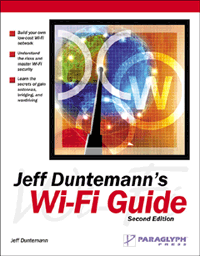Review: Jeff Duntemann’s Wi-Fi Guide, 2nd Edition (book)

Price: $35 (list); $24 (Amazon)
Trial: None
Overview
Jeff Duntemann’s Wi-Fi Guide, 2nd Edition is a detailed overview of many wireless networking topics, current to April 2004 or so. From IEEE’s wireless standards group to wardriving and Pringles antennas, all stones are turned. The sole problem: it’s aimed primarily at Windows users and doesn’t address Apple or AirPort in any detail. While an impediment for Mac-only users, the hardware sections are of general interest, especially for users of non-AirPort wireless networks.

Layout and Organization
Any book with 500 pages and 19 chapters is daunting, so the Wi-Fi Guide starts with the basics of Ethernet (i.e., wired) networks and progressively introduces wireless concepts with conceptual diagrams. Experienced networkers can skip or skim the early chapters, but novices will need the background. As Duntemann stresses frequently, you shouldn’t just plug it in and go—a wireless access point in its default state is an open invitation to bandwidth theft (or worse) by morally flexible passers-by.
On the positive side of wireless use, one chapter discusses wireless communities that work to share network and Internet access over larger areas with a mix of expertise and elbow grease. Brisbane, Australia is specifically highlighted, along with smaller projects in several US cities. Check out the chapter’s links to learn more about what’s happening in your neck of the woods.
After the middle several chapters break down network setup and troubleshooting, wireless security gets five chapters of its own. This is not an accident! People who leave even basic security off become, as Duntemann puts it, “low-hanging fruit,” ripe for picking by anyone within broadcast range. Wireless access points come with security disabled, so you need to follow the extra couple steps to get it going. The basic security protocol, WEP, got a bad rep from high-publicity early failures. It remains suitable for small home and office use, however, especially if people perform simple measures like changing encryption keys (essentially, the wireless password) regularly.
A three-chapter section is aimed at hobbyists and shows how to make “bandwidth expanders,” such as the famous Pringles can antenna. These antennas increase the gain of your wireless receiver, giving you better reception across distance or dead spots. In truth, a cardboard Pringles can isn’t a good subject for this, says Duntemann, lacking the conductivity of a real tin can. Basic wireless antennas, including those in early AirPort cards, are so anemic that any antenna is a major improvement. Building an antenna is cheap and easy for the technically inclined, but the book also lists several companies that provide good off-the-shelf options.
The last couple of chapters cover wardriving, the mobile hobby of running a wireless detector like iStumbler on a portable computer and traveling around town mapping wireless access points. The book makes a sharp distinction between those who record the expanding wireless world and those who look to steal bandiwidth from the unsuspecting. If you are in the latter category, don’t bring it up on the author’s wardriving forums! To paraphrase iTunes, “don’t steal bandwidth.”
Observations and Opinions
Duntemann has over 30 years of experience in computing and (assumedly) writing about it. This second edition is well-polished, with only technical updates needed whenever a third version comes along. A chapter on AirPort, though—if only!
2004 will likely bridge eras in wireless networking, as we reach the end of its “first wave” and technology lessons painfully learned. Sometime in 2005, look for the adoption of more comprehensive wireless security and “roaming” (moving freely within larger wireless networks) standards. With growing consumer confidence and falling prices, wireless Internet should rapidly gain the business dollar with Joe Consumer not far behind. After all, why run all that cable? Let the dust bunnies behind the couch herd themselves.
Strengths
The Wi-Fi Guide is more accessible than 90% of 500-page technical books, broken into logical sections and only repeating that which bears repeating. (Turn on wireless security! Do it; turn it on!) Windows users get the benefit of many illustrations and examples with popular wireless hardware models.
Hobbyists will enjoy the project section and everyone will learn something new. An example? MAC address filtering is practically worthless as a security mechanism, but helps when creating office networks with multiple access points. Allowing a specific access point to accept specific MAC addresses keeps other nearby access points from causing interference on the computer in question.
Weaknesses
For all the author’s skill with wireless networks, the book is oriented at Windows and therefore of less use to Mac users. With ample Mac content, it’d deserve an Excellent rating instead of “merely” Very Nice.
Reader Comments (0)
Add A Comment